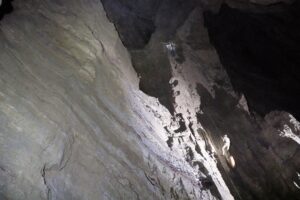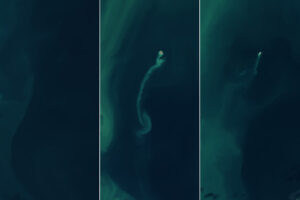Iceland is where North America meets Europe. The Mid-Atlantic Ridge, a 65,000km-long underwater boundary separating these two continental plates, snakes passes right through the island. And weirdly, the Sunnumork Shopping Center is one of the places that shows this duality best.
Do you want to shop in Europe or North America today?
The small town of Hverageroi in southern Iceland is a hotspot of volcanic and tectonic activity. Hverageroi not only has hot springs and fumaroles, it is also one of the only locations in the Arctic where you can grow tropical fruits, thanks to its thermal greenhouses.
However, the town’s main attraction is its shopping mall. Sunnumork Shopping Center may not look unusual at first. There are a few stores, a cafe, and a tourist information center. But look around a bit and you’ll also find a glass-covered crevice giving a window to scorching lava below.

Silfra fissure in Thingvellir National Park is another meeting point between the two continents. Photo: Shutterstock
During the construction of the mall in the early 2000s, a thin, deep crevice surprised workers. Officials found that the crack was the boundary between the North American and Eurasian plates, the Mid-Atlantic Ridge.
But the discovery did not change the developer’s plans. Once construction was finished, builders placed glass tiles on the floor so visitors could see the chasm below.
Mechanics of the Mid-Atlantic Ridge
The Mid-Atlantic Ridge is the world’s longest mountain range. Ninety percent of it is underwater, but it rises above sea level in Iceland.
There are three main plate boundaries: divergent, convergent, and transform. Divergent plate boundaries move away from each other. Convergent ones push together. With transform boundaries, the plates slide against each other.
The North American and Eurasian plates diverge from one another because of rising convection currents. This creates a bulge with ridges, faults, earthquakes, volcanoes, and fissures. They estimate that this bulge formed around 200 million years ago when the Pangea supercontinent broke apart.
The Mid-Atlantic Ridge constantly moves. The plates move away from each other at an average rate of 3mm per year, and the ridge widens by 2.5cm per year. This may seem underwhelming, but the movement can cause devastating earthquakes.
In 2008, southern Iceland experienced a 6.3-magnitude quake. The Sunnumork Shopping Center subsequently installed an earthquake simulator and exhibition for customers to get a taste of what an earthquake felt like.

The Rift Valley between Europe and North America. Photo: Shutterstock
According to UNESCO, the discovery of the Ridge in the 1950s helped cement the science behind the “seafloor spreading theory.” This theory explored how diverging tectonic plates create new oceanic crust as convection currents thrust molten rock to the surface.






